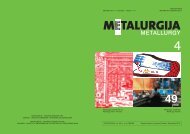PDF - 2453 kB - CARNet
PDF - 2453 kB - CARNet
PDF - 2453 kB - CARNet
Create successful ePaper yourself
Turn your PDF publications into a flip-book with our unique Google optimized e-Paper software.
important role of the carbon �C 2+ � and �C 4+ � ions on the<br />
effectiveness of carbide slag metal extraction process.<br />
EXPERIMENTAL, RESULTS AND DISCUSSION<br />
Basic reaction describing the carbide dissociation<br />
mechanism is:<br />
� Xm Cn���X m+ � + � C n- � (1)<br />
To stand of carbon as of ion �C - � is impossible acceptable,<br />
because element this having construction 1s 2<br />
s 2 p 2 can create following ions:<br />
�C - ���C 2+ � + 3e (2)<br />
or ��C 4+ � + 5e (3)<br />
or ��C + � + 2e + 1e (4)<br />
or ��C 4- � - 3e (5)<br />
Described with equalizations 2-5 ionic reactions explain<br />
specificity of influence of carbon in carbide slags.<br />
Show, that his melting and strong influence reducing results<br />
from occurrences in slag mostly of ions � C 2+ � or<br />
� C 4+ �. Released in this manner in slag electrons are<br />
main link in mechanism exchanges of ions on border of<br />
distribution of phases slag-metal. In consequence after<br />
carbon dissolution in including oxygen alloy is possible<br />
setting reaction :<br />
�C� +�O� = (CO) (6)<br />
It taking into account reactions 2 and 3, the figure of<br />
oxygen ions was put in to the liquid metals how �O 4+ �<br />
as well as �O - �. It the possibility of setting reaction was<br />
put additionally (6). Because carbon (how in reaction 6)<br />
in solution of copper alloys come from carbides of alloy<br />
additions (mainly M’C), it can the total figure of ion reactions<br />
of carbon monoxides formation have figure:<br />
�M’C� + �O� = �M’� + (CO) + 2e (7)<br />
With introduced reactions (6) and (7) it is possible to<br />
bring in, that possible is forming gas blisters - (CO).<br />
They can be one of main causes of casts porosity. According<br />
as with theory of segregation during solidification<br />
in layer diffusive comes to crossing of value of<br />
dissolubilities. It has similarly how in steel - makes in<br />
ingot moulds, this to lead to dissolved reaction carbon<br />
and oxygen (how at 7).<br />
The oxygen can also react with the carbon in solid<br />
state, coming from for example from facings of stove. It<br />
melting near absence of oxygen in atmosphere such reaction<br />
were it been possible to record:<br />
�O� + < C >=(CO) (8)<br />
Over presented analyses’ found affirmance in<br />
founders’ opinions many times. It was affirmed the difficulties<br />
of procurance from alloys with the silicon,<br />
nickel, alluminium whether the iron the casts without<br />
gas blisters. Exchanged alloy additions create carbides.<br />
The increased content of carbon be moved also the porosity<br />
in melting of alloys with different additions<br />
(Table 1).<br />
A. W. BYDA£EK: THE ANALYSIS OF THE CARBON ATTENDANCE IN COPPER ALLOYS<br />
Table 1 The Results of the chemical analysis and the<br />
mechanical properties of the B555, B101 alloys<br />
If more rathe desoxygenation such alloys did not accomplished<br />
deep, then reaction had to set (8). Numerous<br />
blisters were in cast effect. In the melting atmosphere<br />
the wide part of CO/CO2 and the vapors of the component<br />
alloy (M’) or their oxides (M’O) was observed.<br />
The author’s test and industrial investigations shown the<br />
significant contents of carbon in some metallic phaze.<br />
The microanalyses’ of silicon bronze confirmed clear<br />
contents of carbon, mainly near smelting in graphite<br />
crucibles (Figure 2).<br />
On the basis of the thermo gravimetrical measurements<br />
an original methods, which modulates real conditions<br />
of reacting, was elaborated �1,9�. On the basis of<br />
this measurements system a method of interpretation the<br />
slag property was proposed. The method enables estimation<br />
of refining features of slag (S). In the experiments<br />
with derywatograph refined alloy is replaced with<br />
non-metallic inclusions (WN) in the melting pot. The inclusions<br />
are introduced into the slag in proportions<br />
which respond with the melting losses of the alloy.<br />
Al2O3 standard is proposed to be replaced with S+R<br />
(where R-reducer) refining sample. This made it possible<br />
to achieve thermal and mass effects concomitant<br />
with reduction reactions of WN which are is in the slag.<br />
The analysis of slag containing WN �4� allowed to establish<br />
the possible combinations of EW and r values to-<br />
METALURGIJA 50 (2011) 4, 278-280 279<br />
Alloy<br />
B555<br />
CuSn5Zn5Pb5<br />
B101<br />
CuSn10P<br />
Kind of<br />
crucible<br />
�O� /<br />
ppm<br />
Porosity<br />
%<br />
�C� /<br />
ppm<br />
ceramic 12 1,1 0-10<br />
graphite 49 1,8 —<br />
ceramic 10 0,7 0-10<br />
graphite 86 3,2 10-20<br />
a) b)<br />
c) d)<br />
Figure 2 Microanalysis of chosen components of bronze<br />
(a) the be drowned in graphite crucible BK331:<br />
b) - carbon, c) - silicon, d) - iron

















